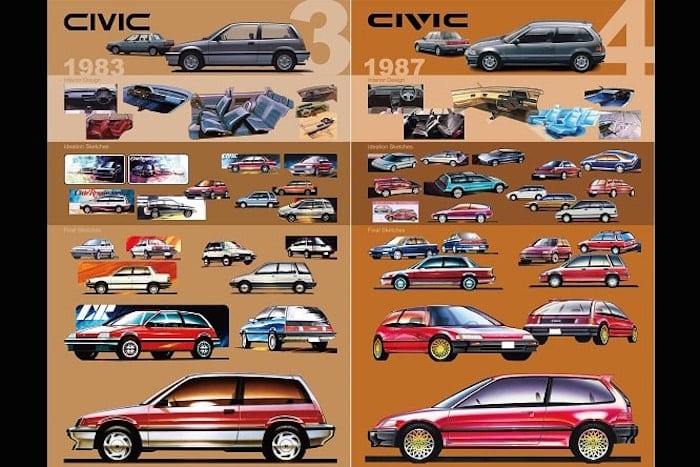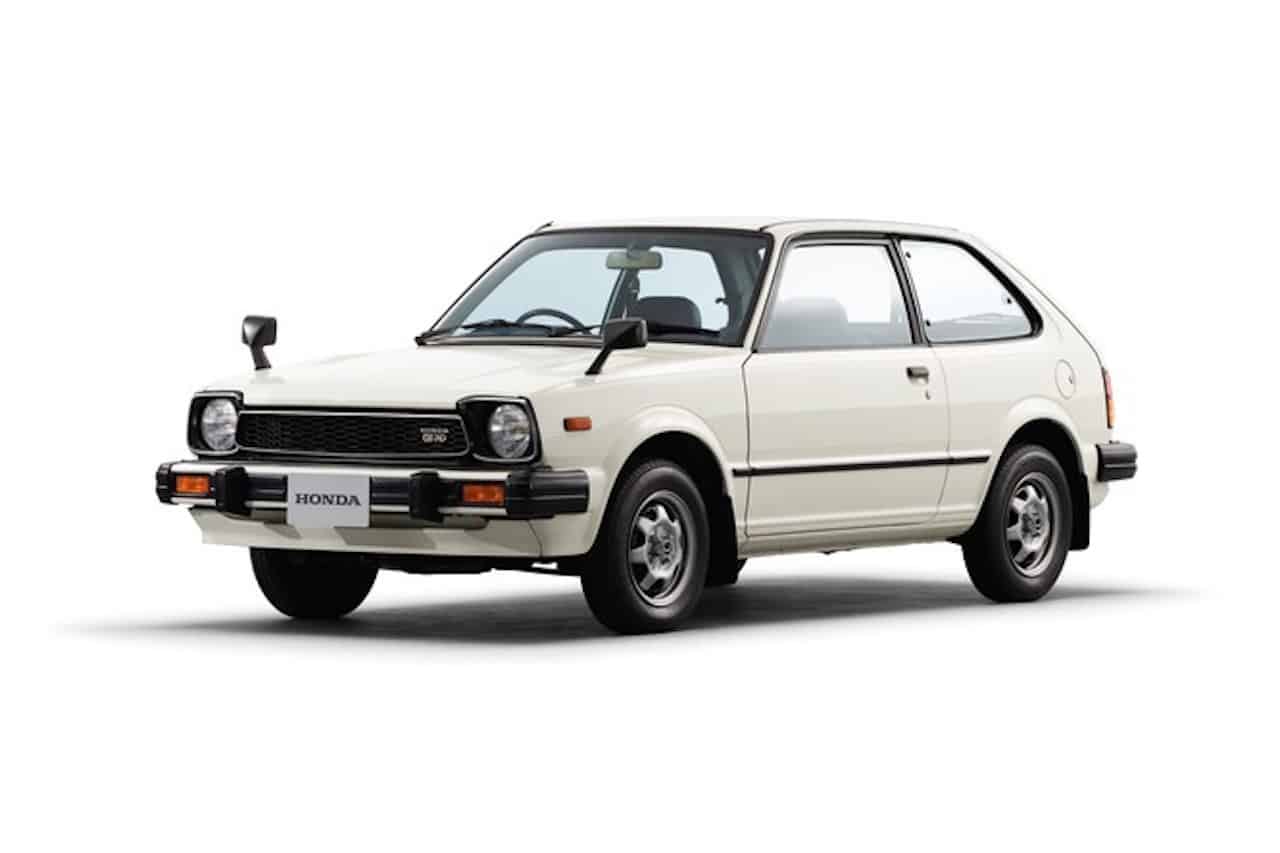Honda Civic he tells himself and still amazes us through his 50 years of history. Here, today Honda Civic challenges the electric future and its story has to be told. Honda Civic was born in 1972 and has sold more than 27.5 million units worldwide. It is a car that in its variants has covered different types of customers. For example the Type R which had the honor of representing the Civic brand on the circuits, as a point of reference in the front-wheel drive sedan segment.
Honda Civic, entering its sixth decade with the eleventh generation, continues to set new benchmarks for the category and exceed the expectations of customers around the world.
The continued popularity of the Civic is testament to the pioneering work done by Honda engineers over the past fifty years. Each generation introduced a progressive evolution of the original Civic design. However, introducing advanced technologies and new levels of performance, while keeping the concept of the first generation unchanged. Create a car that is fun to drive, spacious and economical.
1972–1979: a Civic for all citizens
The first Civic, developed as a global car for all markets. Above all, capable of offering exceptional practicality in daily driving. Among the first Hondas to be sold in Europe. Honda Civic quickly won acclaim for its compact design, impressive fuel efficiency and extraordinary practicality. Equipped with a revolutionary CVCC (Compound Vortex Controlled Combustion) engine. Civic becomes the first vehicle to comply with the world’s strictest emissions legislation, the Clean Air Act of 1970. It sets the standard for future emissions targets in the global automotive industry. The first generation Civic was produced at the Japanese Suzuka plant. This with a total production volume that reached one million units in the first four years.
1980s: the growth of Civic
In 1979, following the success of the first version, the second generation of Civic arrives. Then with an improved 1.3-liter CVCC-II engine that offered smoother and more efficient power delivery. The model range was expanded with the addition of a 1.5 L sedan sedan, hatchback and station wagon. A five-speed manual transmission is also added. The Civic II introduces a distinctive new two-volume trapezoidal design. From the front grille and the more angular looking headlights. As Civic’s popularity grows. This version was soon replaced by a new model, developed to meet the demand for more spacious cars.
The third generation, which arrived in 1983, comes with a longer wheelbase and a more squared-off design. It marks the introduction of the Honda “Man Maximum-Machine Minimum” principle, an approach to design developed around the person. Where technology and design were put at the service of the driver and passengers. Even today, this principle helps to define all Honda models, to offer the space and practicality that modern motorists expect to receive.
Civic III was available in three versions. A three-door to enhance sporty driving, a more practical four-door sedan and a five-door Shuttle station wagon. It offers exceptional spaciousness and practicality. Also introduced is the sportier Civic Si variant, equipped with a 1.6 L DOHC engine with straight four.
 50 years of Honda Civic happy birthday
50 years of Honda Civic happy birthday
1987–2000: new standards of quality and performance
In 1987, the fourth generation of Civic introduces a new range of engines. With the Honda VTEC system (Variable Valve Timing and Lift Electronic Control). The variable valve timing mechanism revolutionizes engine technology. It offers more performance at high revs and improved fuel consumption at low revs, winning the Civic numerous awards.
However, the fifth generation of Civic comes soon after, in 1991, it debuts with a more elegant and aerodynamic shape. With a sportier appeal that at the same time maintained everyday functionality that has now become synonymous with the Civic in the collective imagination. The sixth generation Civic developed to create value beyond that in its class. In the 1990s, low fuel consumption and other environmental protection measures gained more weight, and for this reason the model was equipped with a newly developed VTEC engine. In addition, the “Hondamatic”, a continuously variable automatic transmission (CVT), is previewed. It offers smooth gear changes and fuel consumption comparable to that of a manual model.
Building on the exceptional dynamic capabilities of the standard Civic, in 1997 Honda comes the Type R variant. With the aim of delivering the most extreme performance ever achieved by the Civic. This car symbolizes 25 years of success for Honda in the competitive hot hatch industry.
2001–2021: the Civic of the new millennium
The seventh generation landed in 2000 and in 2001 the first Civic equipped with hybrid technology was launched. This Civic establishes the record as the most fuel-efficient 5-seater series production vehicle in the world in terms of consumption, with extraordinary values of 29.5 km / L.
In 2005, the eighth generation arrives in the European markets with a futuristic style, distinguished by a Perspex grille and triangular details including the dual exhaust, which have made the Civic one of the most characteristic vehicles on the road. It is the first generation of Civics to feature Honda Magic Seats. They allow the rear seats to be raised to create a vertical loading area. The engineers achieve this by moving the fuel tank under the front seats. A solution still used today in various Honda models and which allowed to significantly increase the spaciousness and practicality of the interior.
The ninth generation Civic introduces further updates to offer its customers a complete package, from class-leading efficiency levels. Equipped with a revamped 1.6L DTEC engine, the car achieves the Guinness World Record title for “lowest fuel consumption in all 24 neighboring EU countries”. It records an average of 2.82L per 100km (100.31mpg) over a 13,498km (8,387 mile) trip over a 25-day journey across all 24 contiguous EU countries.
The tenth generation, completely renewed, arrives in 2015 with the choice of two TURBO VTEC engines. Incorporates for the first time, the system of advanced functions for safety and driving assistance Honda SENSING. Designed with a stiffer chassis and increased dynamic performance, it proves to be the perfect platform for the 2017 Civic Type R, setting new performance limits for front-wheel drive hatchbacks. The car is universally praised for its handling and responsiveness, for its instantaneous response to the accelerator. The high top speed, stability and exceptional braking force. All of which helped push the Type R to a new lap record for front-wheel drive cars at the Nürburgring Nordschleife, Germany in April 2017.
2022: a new era of Civic
With 50 years of tradition behind it, the eleventh-generation Civic combines performance and efficiency with improved levels of interior comfort, aesthetics and overall practicality. The new version marks an important milestone for Honda in Europe, representing the latest model in the range to be electrified, to complete Honda Motor Europe’s commitment to electrify all models by 2022. It also boasts the most advanced version of the award-winning e: HEV Full Hybrid engine from the House, capable of delivering engaging performance with truly remarkable fuel efficiency and emissions.
“Since its first generation, which has been so successful, the Honda Civic has been an iconic model for European customers,” commented Tom Gardner, Senior Vice President of Honda Motor Europe Ltd. “The eleventh generation integrates functionality, practicality and comfort at the heart of the very first generation of Civic. It has been designed to ensure that the powertrain, steering and suspension deliver engaging levels of performance, with the traditional driving pleasure that has always been at the heart of Civic’s success. ”
















Leave a Reply
View Comments